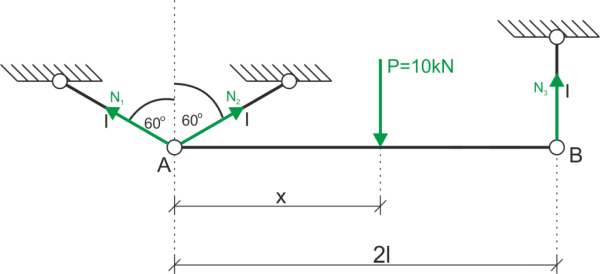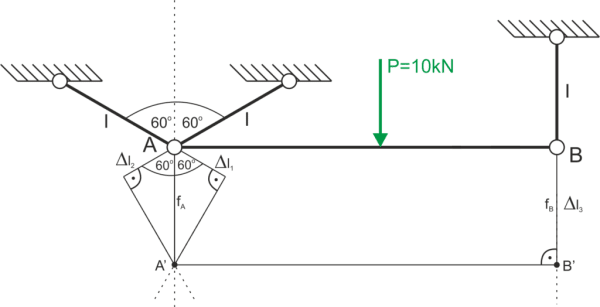Solution
Classic Solution

Calculation of reactions using static equilibrium equations \begin{aligned} &\sum{M_{A}}=0\\ &P\cdot x - N_{3}\cdot 2l=0\\ &N_{3}=\frac{1}{2}Px\\ \\ &\sum{X}=0\\ &-N_{1}\cdot\sin\alpha + N_{2}\cdot\sin\alpha=0\\ &N_{1}=N_{2}\\ \\ &\sum{Y}=0\\ &N_{1}\cdot \cos\alpha + N_{2}\cos\alpha - P + N_{3}=0\\ &N_{1}\cdot\cos\alpha + N_{1}\cdot\cos\alpha=P- \frac{1}{2}Px\\ &N_{1}=\frac{P(1-\frac{1}{2}x)}{2\cdot\cos\alpha}\\ &\cos60^{o}=P(1-\frac{1}{2}x)\\ &N_{1}=P(1-\frac{1}{2}x)\\ &N_{2}=P(1-\frac{1}{2}x)\\ \end{aligned} Geometric condition from the task

In order for the beam to move parallel downwards, the displacements of point A and B must be the same \begin{aligned} &f_{A}=f_{B}\\ &f_{B}=\Delta l_{3}\\ &\frac{\Delta l_{2}}{f_{A}}=\cos60^{o}=\frac{1}{2}\\ &f_{A}=2\cdot\Delta l_{2}\\ &2\cdot\Delta l_{2}=\Delta l_{3}\\ \end{aligned} We calculate the elongations of the rods \begin{aligned} &\Delta l=\frac{Nl}{EA}\\ &\Delta l_{2}=\frac{P(1-\frac{1}{2}x)\cdot 1}{EA}\\ &\Delta l_{3}=\frac{\frac{1}{2}Px\cdot 1}{EA}\\ \end{aligned} We substitute into the geometric condition and calculate the position of the force "x" \begin{aligned} &2\cdot\frac{P(1-\frac{1}{2}x)\cdot 1}{EA}=\frac{\frac{1}{2}Px\cdot 1}{EA} \ \ \ \ \ |\cdot EA\\ &2\cdot P(1-\frac{1}{2}x)=\frac{1}{2}Px \ \ \ \ \ \ |:P\\ &x=\frac{4}{3} m\\ \end{aligned}
If you have any questions, comments, or think you have found a mistake in this solution, please send us a message at kontakt@edupanda.pl.
